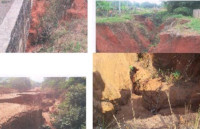Impact Of Temperature And Rainfall Disparity On Human Comfort Index In Enugu Urban Environment, Enugu State, Nigeria
Keywords:
Temperature, Human comfort index, Rainfall, heat, Urban environmentAbstract
The rate of changes in temperature and rainfall disparity constitutes severe impact on human comfort index in Enugu Urban Environment. The area is characterized with built-up structures, little or no vegetation cover and high urban heat island which affect temperature and rainfall distributions adversely. This study then becomes indispensable because of the continuous increase in the rate of changes in temperature and rainfall disparity over the years. Temperature, rainfall and human comfort index data for the period of 1970-2005 were collected for the purpose of establishing the rate of temperature and rainfall disparity as well as its impact on human comfort index within Enugu urban environment. Results show among others that temperature and rainfall over the years fluctuates wildly and has grave impact on human comfort index. The study established that the consequences of temperature and rainfall disparity are severe biodiversity and vegetation loss which affects human comfort index adversely. In that light, it then becomes expedient to promote Urban Planning-Meteorological Advisory Services, substantial planting of trees, adaptation measures and Specialized Research Programmes (S.R.P) in the area.
References
Anyadike, R. N. C (2002). Climate and Vegetation. In G.E.K Ofomata (ed) A Survey of the Igbo Nation. Ibadan: Africana First Publishers
Adinna E. N., Enete I. C. and Okolie, T. (2009). Assessment of urban heat island and possible adaptation in Enugu urban using Landsat-ETM. Journal of Geography and Regional Planning Vol. 2(2), pp 030-036
Barradas, V. L. (1991). Air Temperature and Humidity and Human Comfort Index of Some City Parks of Mexico City. Springer: Berlin/Heidelberg
Bhalme, H. N. (1999). Agriculture, Food and Climate Report. World Climate Programme, Application and service. Indian Institute of Tropical Meteorological, Geneva.
Blair, J. (2002). Rainfall Variability and Crops Yield. National Science Foundation (NSF) Pub. Scott Collins.
Fay, P. (2000). Impact of Climate on Rice Production. National Science Foundation (NSF) Pub. Scott Collins.
Fukazawa, T., and Havenith, G. (2009). Differences in Comfort Perception in Relation to Local and Whole Body Skin Wettedness. European Journal of Applied Physiology, 106 (1), 15-24.
Gnomes (1996), Weather Analysis and Crop production. National Science Foundation Pub. Scott Collins.
Government of Anambra State (1978). A comprehensive physical Development Plan for Enugu. Enugu: Government Press.
Heisler, G. M. and Wang Y. (2002). Applications of a Human Thermal Comfort Model. Fourth Symposium on the Urban Environment. Norfolk, VA, American Meteorological Society, Boston, MA, 70-71
Holden, Peel D. and Thompson A. (1993). Economic Forecasting. London: Vitalis Publication
Knapp, A., Fay, P. and Blair, J. (2008). Rainfall Variability Analysis. National Science Foundation (NSF) Pub., Scott Collins.
Littlejohn, S.W. (2001). Theories of Human Communication. Belmont, CA: Wadsworth/Thomson Learning.
Mabogunje, A. L. (1972). Regional Mobility and Resource Development in West Africa. Montreal: McGill-Queen's University Press.
Mcbride and Buiting (1971). Comfort Index Indicator. United States Patent
Myers, N. (1991). The Rich Diversity of Biodiversity Issues. Reaka-Kudla et al. 125-134.
Nnamani C. (2002). By the Hills and Valleys of Udi and Nsukka. The People, their Heritage, their Future. Tell Magazine, No. 50, December 16. pp. 64 - 69.
NPC (1991, 2006). Census Figures. Abuja: National Population Commission.
Obasi G. O. P. (2003). Statement at the International Symposium on Climate Change (ISCC) Beijing, China, 31 March 2003.
Ogbuene, E. B. (2007). Relationship between Rainfall, Soil Temperature at Various Depth and Implication on Crops Yield. Unpublished M.Sc Dissertation, ESUT, Enugu.
Ogbuene, E. B. (2010). The Role of Tourism Potentials in the Development of Environmental Resources in Ugbo Towm, Awgu of Enugu State Nigeria ed. Journal of Geography and Development, Benue State University, Makurdi
Ojo, O. (1977). The Climate of West Africa. Hesnemam Publication. pp. 191-193
Oke, T. R. (1982). The Energetic Basis of Urban Heat Island. J.R. Meteorol. Soc. 108 (455): 1 - 24.
Taha, H. (1997). Urban Climates and Heat Islands:Albedo, Evapotranspiration and Anthropogenic heat. Energy and Buildings. 25 (2): 99 - 103.
Unger J., Simeghy M. and Zoboki J. (2001).Temperature cross - section Features in an Urban Area. Atmospheric Research, 58 (2),117 - 127.
United Department of Agriculture and Forest Service (USDA) (2009). Tree Influences on Human Comfort
UNICEF (2007). The Nigerian Child. United Nations Children's Fund, Vol. 1, Issue 1.
Voogt, J. A. (2004). Urban Heat Islands: Hotter Cities. America Institute of Biological Sciences.
Wei-wu W., Li-zhong Z. and Ren-chao W. (2004). An analysis on spatial variation of urban human thermal comfort in Hangzhou. China College of Environment.
Yuk yee Y. and Oliver J. E. (1995), the CLO: a Utilitarian Unit to Measure Weather/Climate Comfort, Hong Kong Baptist University, Hong Kong Department of Geography, Geology and Anthropology, Indiana State University, Terre Haute, Indiana USA

